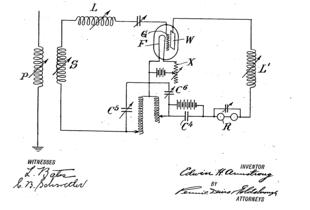True to our name here at OneTubeRadio.com, we frequently feature one tube radios. And more often than not, they are regenerative receivers. The regenerative receiver was popular in the early days of radio because it could deliver so much performance out of a simple circuit. The single tube, in addition to serving as the detector, had some of its output fed back into the tube to amplify. If there was too much feedback, the receiver would break into oscillation, which would result in a squealing sound from the headphones, as well as those of other nearby receivers. The anti-squeal campaign featured in an earlier post showed how this could be the bane of other local listeners. But this oscillation also allowed the reception of CW (and later SSB) signals by simple receivers.
As far as I can tell, the regenerative receiver was first introduced to the public a hundred years ago this month in an article in the January 1916 issue of Electrical Experimenter.
An article by Frank J. Collins entitled “Regenerating Audion Circuits for Wireless Receiving” includes the circuit diagram shown above. If the circuit looks familiar, it’s because it’s the same circuit, with minor variations, used in most of the one tube radios shown on this site.
The details given in the article are for the construction of a longwave version of the set. “As most of the high-power transatlantic and transpacific stations use wave lengths of from 5000 to 10,000 meters [30 to 60 kHz], dimensions are given to cover these wave lengths only.” The author reports that with an aerial 500 feet long at least 10 feet above ground, reception of strong stations 2000-4000 miles away was possible, day or night, but that the set would work well with an antenna of 100 feet.
While this seems to be the first popular construction article showing how to make a regenerative receiver, it was a couple of years old by the time this article was written. It was invented by Edwin Armstrong in 1912 and patented in 1914 (US Patent 1113149).
The article warns that “while the coils described herein may be constructed by experimenters, they are not permitted to sell them to others for the purposes described, as the invention is patented.”
The author concludes by noting that “this type of apparatus and connections are well worth constructing and using, as it constitutes the most advanced means known at the present time in the reception of both damped and undamped radio signals.”
Because of the relative simplicity of the circuit, a regenerative receiver is an ideal project even today. I have featured numerous examples in this site, most of which can be easily constructed using the vintage plans, although some parts require a bit of creativity to replace with modern equivalents. Sets designed for the AM broadcast band will give immediate gratification, since there’s guaranteed to be something that can be tuned in immediately after making the last connection. Shortwave sets are surprisingly good performers, and will pull in signals from around the world with little difficulty.
For those wishing to bypass the parts procurement process, a number of good kits are available. For example, the kit shown in the illustration here is available at Amazon at a reasonable price. It’s a two-tube set that tunes both standard AM and shortwave. For those who don’t mind substituting modern transistors for the tubes, QRPkits.com puts out an excellent kit, the Scout Regen Receiver, It tunes only shortwave, but covers enough territory to almost ensure that you’ll be able to tune in something interesting, day or night. At night, the dial will be packed with amateur, commercial, and shortwave broadcast signals from around the world.
My son and I put together the Scout Regen a few years ago, and it is an excellent performer for such a simple design. One that appears to have similar performance, but probably a bit easier to put together because of its wide-open layout, is the Ozark Patrol receiver designed by David Cripe, NM0S and distributed by the Four State QRP Group. If you build any of these, you’ll have a very sensitive receiver capable of pulling in many interesting signals, and you’ll also be working with the same circuit employed by experimenters a century ago.




Pingback: 1916 Regenerative Receiver | OneTubeRadio.com